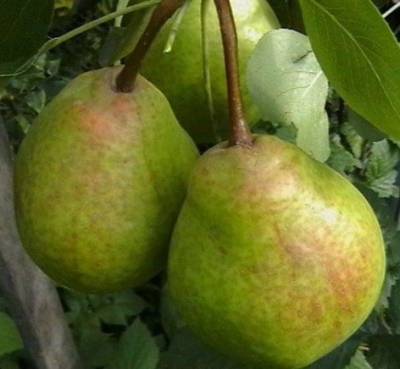
- Authors: Chelyabinsk
- Fruit weight, g: 100-120
- Ripening terms: autumn
- Fruit picking time: in October
- Appointment: universal
- Growth type: medium height
- Yield: high
- Height, m: up to 3.5-4
- Crown: semi-spreading
- Fruit shape: round, pear-shaped
Pear variety Rich will allow you to get a good harvest, therefore it is very popular with gardeners. At the same time, the variety is considered unpretentious in care and resistant to negative environmental influences.
Description of the variety
These fruit trees are medium-sized. The height of an adult plant is up to 3.5-4 meters. The vegetation has a semi-spreading crown. Average leafiness.
Fruit characteristics
Ripe fruits have a pear-shaped or round shape. The weight of one fruit can reach approximately 100-120 grams. Ripe pears are medium in size.
Their main color is yellow-green. The integumentary color is red-pink. During the ripening period, the fruit will turn green. Their flesh is quite juicy and tender. Her color is light cream. The skin on them is thin, of medium density, it is absolutely smooth and semi-oily. The plucked fruits can be stored for up to three months.
Taste qualities
Ripe pears of this variety have a pleasant sweet taste without astringency. In addition, they have a distinct aroma.
Ripening and fruiting
Pear Rich refers to the autumn varieties. Fruit picking dates are in October. Moreover, they can be consumed immediately after removal from trees. The frequency of fruiting in this species is regular.

Yield
Pear Rich has a high yield. From one tree it will be possible to collect up to 40-50 kilograms of ripe fruits per season. The variety brings a rich harvest every year.
Landing
When planting, be sure to leave free space between the plants. In this case, you should make a distance of 3.5-4 meters. It is also worth leaving about 5-6 meters between the rows.


Growing and care
It is recommended to plant this pear variety in a well-lit and elevated place on the land plot. Over time, the root system of such a fruit crop will begin to actively grow and become powerful. If groundwater is located close to such trees, then the risk of losing a pear due to the soaking of the root system will sharply increase.
This variety is partially self-fertile, therefore it is recommended to plant varieties of the same flowering period next to it. They will act as pollinators.
The soil for planting this variety must be as fertile as possible. The best option would be drained soil. Peat and humus should be immediately introduced into the planting holes.Pear Rich prefers sandy loam lands. You can pre-add a little clay to the planting holes. Potassium salts and superphosphate can also be added immediately as fertilizers.
Wells for this culture should be prepared in advance. Dig holes with a depth of 60 centimeters. Their diameter should be about one meter. It will be necessary to drive a stake firmly into the center of each dug hole; it is covered with earth mixed with organic fertilizers.
It is better to process seedlings immediately before planting in a solution with a special growth stimulant. And you can also use disinfecting drugs that will prevent the development of various diseases of the culture.
The soil should be well tamped with your feet so that a small mound with a peg in the center appears as a result. After that, a young seedling is placed on the top of such a hill, its root system is carefully placed along the slopes of the hill. Falling asleep vegetation, it is important not to deepen the root collar. It will have to stay above the surface of the earth. Otherwise, the plant may simply die.
Saplings must be tied to a peg in several places at once so that they do not deform under the influence of strong winds. Pour 20-30 liters of clean water under each planted tree. Moreover, you can add a little lime at the same time. It allows you to prevent the development of various diseases in the culture.
It is recommended to mulch the earth circle near the plant. This is done so that the soil remains moist for as long as possible. For this, you can use straw, sawdust and humus.
In the future, the plants will need regular loosening of the earth, abundant watering, and the introduction of nutritious fertilizers. And also we must not forget about preventive measures against various pests and diseases.
With the onset of spring, it is best to apply organic fertilizing and complex mineral fertilizers. Ammonium nitrate or urea is often used.
Watering should be carried out only during certain periods: in May during the budding period, in June a week after the end of flowering, in early July, and also in September during leaf fall.
You need to water the near-trunk circle. One tree will take about 7 buckets of water. Every 5 years, the pear will have to be rejuvenated. For this, old and diseased branches are cut out. This procedure is recommended at the beginning of the summer period.




Like any other fruit trees, the pear needs protection from various diseases and pests. When planting a pear on your site, you need to know in advance what diseases you should beware of. To successfully carry out the struggle, it is necessary first to correctly identify the cause of the problem. It is important to distinguish signs of disease from manifestations of the presence of insects, mites, caterpillars and other types of pests.





































































